de Havilland Canada DHC-5 Buffalo
The de Havilland Canada DHC-5 Buffalo is a short takeoff and landing (STOL) utility transport turboprop aircraft developed from the earlier piston-powered DHC-4 Caribou. The aircraft has extraordinary STOL performance and is able to take off in distances much shorter than even most light aircraft can manage.
| DHC-5 Buffalo | |
|---|---|
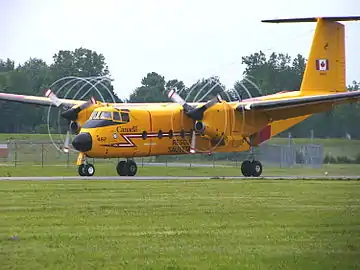 | |
| A CC-115 Buffalo of 442 Transport & Rescue Squadron at Rockcliffe Airport in Ottawa, 2004 | |
| Role | Utility aircraft |
| Manufacturer | de Havilland Canada |
| First flight | 9 April 1964 |
| Introduction | 1965 |
| Primary user | Royal Canadian Air Force |
| Produced | 1965–1972, 1974–1986 |
| Number built | 122 |
| Developed from | De Havilland Canada DHC-4 Caribou |
Design and development
The Buffalo arose from a 1962 United States Army requirement for a STOL transport capable of carrying the same payload as the CH-47A Chinook helicopter.[1] De Havilland Canada based its design to meet the requirement on an enlarged version of its DHC-4 Caribou, already in large-scale service with the United States Army, to be powered by General Electric T64 turboprops rather than the Pratt & Whitney R-2000 piston engines of the Caribou. (It had already flown a T64-powered Caribou on 22 September 1961).[1]
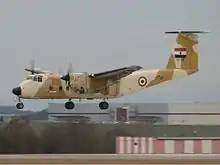
De Havilland's design, the DHC-5 Buffalo, was chosen as the winner of the United States Army competition in early 1963, with four DHC-5s, designated YAC-2 (later CV-7A and subsequently C-8A) ordered.[2] The first of these aircraft made its maiden flight on 9 April 1964.[3] All four aircraft were delivered in 1965, the Buffalo carrying nearly twice the payload as the Caribou while having better STOL performance. The prototype CV-7A was exhibited by the manufacturer at the 1965 Paris Air Show wearing US Army markings. No further US orders followed, however, as at the start of 1967 (See the Johnson-McConnell agreement of 1966), inter-service politics led to large fixed-wing transports being transferred to the United States Air Force,[2] who considered themselves adequately equipped with the Fairchild C-123 Provider.
Company data claims a takeoff distance over a 50 ft (15 m) obstacle of 1,210 ft (369 m) at 41,000 lb (18,597 kg) and a landing distance of over a 50 ft (15 m) obstacle of 980 ft (299 m) at 39,100 lb (17,735 kg) for the DHC-5A model.[4]
In the early 1980s, de Havilland Canada attempted to modify the Buffalo for civilian use. The aircraft was to be branded as the "Transporter." After loss of the demonstration aircraft (SN 103 C-GCTC) at the 1984 Farnborough Airshow,[5] the project was abandoned.
A production DHC-5D Buffalo was used for breaking time-to-height records for the weight category 12,000–16,000 kg (26,430–35,242 lb) on 16 February 1976, reaching 3,000 m (9,836 ft) in 2 min 12.75 sec, 6,000 m (19,672 ft) in 4 min 27.5 sec and 9,000 m (29,508 ft) in 8 min 3.5 sec.[6]
New production
On 24 February 2006, Viking Air of Victoria, British Columbia, a manufacturer of replacement parts for all out-of-production de Havilland Canada aircraft, purchased the type certificates from Bombardier Aerospace for all versions of the DHC-1 through DHC-7 series aircraft, giving Viking exclusive rights to manufacture and sell new aircraft of those types. In December 2008, Viking Air indicated their intention to put the Buffalo series back into production at their home factory in Victoria, British Columbia or in Calgary, Alberta. A potential new production Buffalo would have had Pratt & Whitney Canada PW150 turboprops, a glass cockpit, enhanced vision and night vision goggle capability. The aircraft was proposed as a replacement for the Royal Canadian Air Force fleet of existing DHC-5As but was not one of the three aircraft in the final assessment, in 2016, which selected the EADS CASA C-295.[7][8] Several letters of intent for the DHC-5NG were received in 2014.[9]
Operational history
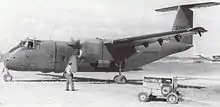
In late 1965, one of the prototype DHC-5s operated by the U.S. Army was deployed to Bien Hoa Air Base in South Vietnam for a three-month evaluation period, assigned to the 2nd Flight Platoon of the 92nd Aviation Company.[10]
The Royal Canadian Air Force first acquired 15 DHC-5A designated as CC-115 for tactical transports. These were initially operated at CFB St Hubert, QC by No. 429 Squadron in a tactical aviation role as part of Mobile Command. In 1970, the Buffalo aircraft were transferred to a transport and rescue role with No. 442 Squadron, No. 413 Squadron and No. 424 Squadron as part of Transport Command. No. 426 Squadron also flew the aircraft for training. Some were leased back or loaned back to the factory for trials and eventually returned to military service.
Three of the aircraft were also deployed on UN missions to the Middle East with No. 116 Transport Unit until 1979. They had a white paint scheme which was retained while they were serving in domestic transport with 424 Sqn in between deployments. On 9 August 1974, Canadian Forces CC-115 Buffalo 115461 was shot down by a Syrian surface-to-air missile, killing all nine CF personnel on board. This represents the single biggest loss of Canadian lives on a UN mission as well as the most recent Canadian military aircraft to be shot down.
In 1975, the Buffalo dropped its tactical transport role and was converted to domestic search and rescue, except for a few that kept serving on UN missions. The initial paint scheme for the SAR converted aircraft were white and red while others still had the original drab paint. The previous drab paint and white paint were eventually replaced with the distinctive yellow and red scheme commonly seen today. The number of aircraft have been reduced to eight, with six on active service, one in storage (recently dismantled) and one used for battle damage training. The remaining operational Buffalos operate in the Search and Rescue role for No. 442 Squadron at CFB Comox. Air Command was renamed the Royal Canadian Air Force in 2011, meaning the CC-115 has served with the RCAF, Air Command and now the RCAF once again. The Buffalo was replaced by the CC-130 Hercules aircraft at search-and-rescue bases in CFB Greenwood and CFB Trenton. As early as 2002, Canada has tried to replace both the Buffalo fleet and the SAR Hercules fleet with a newer aircraft.[11] For some time, the Alenia C-27J Spartan was seen as the likely replacement, with the government considering sole-sourcing the new aircraft.[12] However, after changes in Canada's defense budget as well as accusations of bias from the aerospace industry, the Buffalo replacement program was relaunched as an open competition. After review from the National Research Council, the Department of Defense as well as consultation with the Canadian aerospace industry, a request for proposal was published in 2015.[13] Bidders included Alenia offering the C-27J Spartan, Airbus Defense and Space with its C-295 and Embraer with its KC-390. In 2016, the Department of Defense awarded Airbus a contract for 16 C-295s with delivery scheduled to begin in 2019 and running through 2022.[14]
Production of the DHC-5A ended in 1972 after sales to Brazil and Peru but restarted with the DHC-5D model in 1974. This variant sold to several overseas air forces beginning with Egypt. Production of the DHC-5D ended in December 1986.[15]
Demonstrators for new technologies
The Buffalo was a suitable airframe for converting to demonstrate some new technologies.
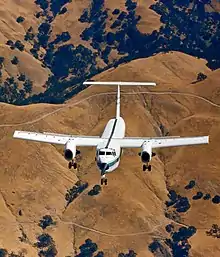
Augmented Wing Jet-flap STOL Research Aircraft
A cooperative NASA/Canadian Government research program on augmentor wing concepts started in 1965 and culminated in the need for a proof-of-concept aircraft. A NASA C-8A Buffalo (later named Bisontennial in 1976) was modified in 1972 for augmentor-wing jet STOL research. The modifications were done by Boeing, de Havilland Canada and Rolls-Royce of Canada Ltd. The wing had a reduced span to give a wing loading representative of future aircraft. It also had full-span leading edge slats, blown ailerons and double-surface flaps enclosing a venturi-shaped passage. The usual turboprop engines were replaced with Rolls Royce Spey 801 SF (Split Flow) bypass engines with a new bypass duct which separated the hot and cold flows to provide both propulsion and augmentor airflow to the powered lift system. [16][17][18][19] The hot flow was directed through Pegasus-engine swivelling nozzles to ensure it deflected with the flap downwash. The cold flow was directed into the flap venturi and entrained extra airflow.[20] Beginning in 1972 with its first flight in this experimental configuration, this aircraft was used jointly by the NASA Ames Research Center and the Canadian Department of Industry, Trade and Commerce for STOL research.[18][21]
Quiet Short-Haul Research Aircraft
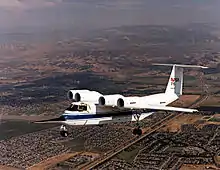
In the late 1970s and early 1980s, NASA used another C-8A Buffalo in the Quiet Short-Haul Research Aircraft program.[16][17][22]:153[23][24][25]
Boeing designed and installed an experimental swept, supercritical wing incorporating a boundary layer control system.[23][24]:8 Instead of the standard engines, this aircraft was powered by four prototype Avco Lycoming YF102 high-bypass turbofan engines (originally from the Northrop YA-9 program) mounted above the wing to take advantage of the Coandă effect.[24]:9–10 In 1980, this aircraft participated in carrier trials aboard USS Kitty Hawk, demonstrating STOL performance without the use of catapults or arrestor gear.[17][22]:154
The aircraft is currently stored at NASA's Ames Research Center in Mountain View, California.[26]
Air Cushion Landing System Aircraft
After demonstrations by Bell aircraft using a Lake LA-4 light amphibian with Air Cushion Landing Gear the development of this type of gear was pursued in a joint effort between the USAF and the Canadian Government by retrofitting a similar system to a medium cargo transport, a Buffalo.[27] The air supply to the cushion was provided by an air supply package consisting of a PT6F-70 and two-stage axial flow fan under each wing. The aircraft also had underwing combination floats/skids.[28][29]
Variants
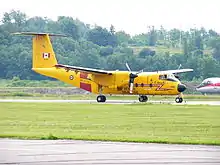
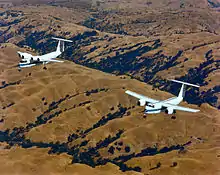
- DHC-5 Buffalo
- Originally designed as a twin-engined STOL tactical, utility transport aircraft for the US Army. Original US Army designation AC-2.
- DHC-5A
- Utility transport aircraft for the Brazilian Air Force, Royal Canadian Air Force and Peruvian Air Force. Canadian designation CC-115.
- DHC-5B
- Proposed version, powered by two General-Electric CT64-P4C turboprop engines. Not built.
- DHC-5C
- Proposed version, powered by two Rolls-Royce Dart RDa.12 turboprop engines. Not built.
- DHC-5D
- Improved version, powered by two 2,336 kW (3,133 shp) General Electric CT64-820-4 turboprop engines.
- DHC-5E Transporter
- Civil transport version.
- NASA / DITC C-8A AWJSRA
- One C-8A aircraft converted into an augmentor wing research aircraft.
- XC8A ACLS
- One C-8A aircraft converted into an air-cushion landing system research aircraft.
- NASA / Boeing QSRA C-8A
- One C-8A converted into a quiet short-haul research aircraft.
- Viking DHC-5NG Buffalo NG
- Proposed redesigned new production version to be built by Viking Air. NG is the company marketing term indicating Next Generation[30][31]
Canadian military designations
- CC-115
- Canadian military designation for 15 DHC-5As.
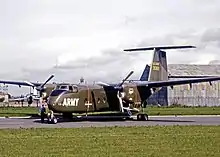
United States military designations
- AC-2
- Designation for four DHC-5s for evaluation by the United States Army.
- CV-7A
- Redesignation of four United States Army AC-2s.
- C-8A
- United States Air Force designation for four CV-7As transferred from the Army in 1967.
Operators
Civil
- Summit Air (8199400 Canada Inc.) operated two DHC-5D (ex-Oman Police Air Wing 1979 and 1981/Shuttle Air Cargo (Congo); transferred from Arctic Sunwest Charters in 2013); C-FASV was sold to Nyassa Air Taxi (Malawi) 2015 with lease to UN OFP[32] and C-FASY stored since 2012 (civil registration cancelled in 2015)[33]
- Ethiopian Airlines 1 DHC-5D (ET-AHI lost in crash 1988)
- Nyassa Air Taxi 1 ex-Summit Air DHC-5D
Military
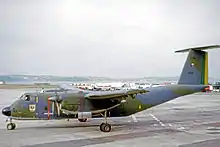
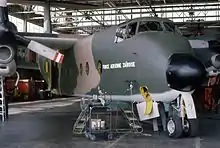
- Abu Dhabi Defence Forces Air Wing – (Retired).[35]
- United Arab Emirates Air Force (Retired)
- Brazilian Air Force (Retired)
- Cameroon Air Force (Retired)
- Chilean Air Force (Retired)
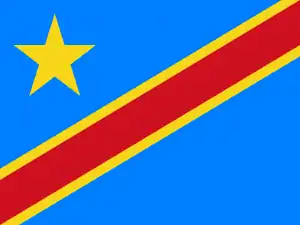 Democratic Republic of the Congo (previously
Democratic Republic of the Congo (previously 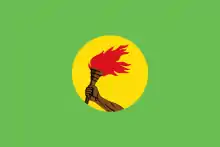 Zaire)
Zaire)
- Ecuadorian Air Force (Retired)
- Ecuadorian Army (Retired)
- Indonesian Army (ex-UAE, Retired)
- Indonesian Navy (ex-UAE, Retired)
- Kenya Air Force (Retired)
- Mauritanian Air Force (Retired)
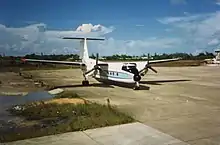
- Mexican Navy (Retired)
- Royal Oman Police Air Wing (Retired)
- Peruvian Air Force (Retired)
- Sudanese Air Force – 1 in service as of December 2015.[37]
- Tanzania Air Force Command – 4 in service as of December 2015.[38] and since retired
- Military of Togo (Retired)
- United States Army (Retired)
- NASA 2 C-8A at Ames Research Center (Retired)
- Zambian Air Force (Retired)
Accidents and incidents
In total, 26 accidents involving hull losses have been recorded.
- On 9 August 1974, a Canadian Forces CC-115 operating for the United Nations was shot down over Syria with the loss of five crew and four passengers.[39]
- At the 1984 Farnborough Airshow, a DHC-5D STOL demonstration ended in a very heavy landing which destroyed the aircraft.[40][41]
- On 21 June 1989, a Peruvian Air Force de Havilland Canada DHC-5D Buffalo crashed into a mountain near Tarma, killing all six crew and 53 passengers in the deadliest accident involving the DHC-5 Buffalo.[42]
- On 17 February 1990, a Zambian Air Force de Havilland Canada DHC-5D Buffalo crashed on approach to Lusaka Airport in Lusaka, Zambia, killing all 29 people on board.[43]
- On 16 April 1992, a Kenya Air Force de Havilland Canada DHC-5D Buffalo lost power in one of its engines, and during its final approach, it overshot the runway and crashed into a residential area near Moi Air Base, Kenya. The accident killed all 42 passengers and four crew members and six people on the ground.[44]
- On 27 April 1993, a Zambian Air Force de Havilland Canada DHC-5D Buffalo carrying most of the Zambian national football team to a FIFA World Cup Qualifier against Senegal in Dakar crashed shortly after takeoff from a refuelling stop in Libreville, Gabon. There were no survivors.[45]
Specifications (DHC-5D)
Data from Jane's All The World's Aircraft 1982–83[46]
General characteristics
- Crew: 3 (pilot, co-pilot and crew chief)
- Capacity: 41 troops or 24 stretchers or 18,000 lb (8,200 kg) payload
- Length: 79 ft 0 in (24.08 m)
- Wingspan: 96 ft 0 in (29.26 m)
- Height: 28 ft 8 in (8.74 m)
- Wing area: 945 sq ft (87.8 m2)
- Aspect ratio: 9.75:1
- Airfoil: root: NACA 643A417.5 (mod); tip: NACA 632A615
- Empty weight: 25,160 lb (11,412 kg)
- Max takeoff weight: 49,200 lb (22,317 kg)
- Fuel capacity: 1,755 imp gal (2,108 US gal; 7,980 l)
- Powerplant: 2 × General Electric CT64-820-4 turboprop engines, 3,133 shp (2,336 kW) each
- Propellers: 3-bladed Hamilton Standard 63E60-25, 14 ft 6 in (4.42 m) diameter fully-feathering reversible-pitch propellers
Performance
- Cruise speed: 227 kn (261 mph, 420 km/h) maximum at 10,000 ft (3,000 m)
- Stall speed: 73 kn (84 mph, 135 km/h) 40 degree flaps at 46,900 lb (21,273 kg)
- Range: 600 nmi (690 mi, 1,100 km) at 10,000 ft (3,048 m) with maximum payload
- Ferry range: 1,770 nmi (2,040 mi, 3,280 km) zero payload
- Service ceiling: 31,000 ft (9,400 m)
- g limits: 2.5g (manoeuvring limit load)
- Rate of climb: 1,820 ft/min (9.2 m/s)
- Take-off run: 2,300 ft (701 m)
- Take-off distance to 50 ft (15 m): 2,750 ft (838 m) (mid cg range)
- Landing run: 850 ft (259 m)
- Landing distance from 50 ft (15 m): 2,010 ft (613 m)
See also
Related development
Aircraft of comparable role, configuration, and era
Related lists
References
Notes
- Air International August 1976, p. 59.
- Harding 1990, p. 104.
- Air International August 1976, p. 70.
- de Havilland Canada: DHC-5A Buffalo STOL Tactical Transport, page 6. de Havilland Canada, May 1971
- "Accident description de Havilland Canada DHC-5D Buffalo Tuesday 4 September 1984 16:18". Aviation Safety Network. Archived from the original on 13 January 2017. Retrieved 11 January 2017.
- Air International August 1976, p. 64.
- Niles, Russ. "Viking Proposes Resurrection Of DHC-5 Buffalo." Archived 27 November 2009 at the Wayback Machine avweb.com, December 2008. Retrieved: 13 September 2009.
- Dec 07, Murray Brewster · CBC News · Posted; December 8, 2016 3:17 PM ET; 2016. "Airbus chosen to build replacements for 50-year-old RCAF search planes – CBC News". CBC. Archived from the original on 2 June 2017. Retrieved 31 December 2018.CS1 maint: numeric names: authors list (link)
- Sarsfield, Kate (12 July 2012). "FARNBOROUGH: Viking evaluates market for DHC-5 Buffalo relaunch". FlightGlobal. Archived from the original on 18 September 2012. Retrieved 30 March 2013.
- "De Havilland (DHC-5) Buffalo, Page 2". Archived 3 July 2009 at the Wayback Machine de Havilland Caribou (DHC-4) and Buffalo (DHC-5) web site. Retrieved: 3 May 2010.
- “C295 wins Canadian FWSAR contest” Archived 26 February 2018 at the Wayback Machine flightglobal.com, 8 December 2016. Retrieved 29 September 2018.
- "Report: DND to look at single bid for search planes." Archived 19 June 2008 at the Wayback Machine cbc.ca, 3 January 2007. Retrieved: 13 September 2009.
- “Procurement timeline: Fixed-wing search and rescue aircraft” Archived 30 September 2018 at the Wayback MachinePublic Services and Procurement Canada,7 February 2018. Retrieved: 29 September 2018.
- Trimble, Stephen (8 December 2016). "C295 wins Canadian FWSAR contest". Flightglobal.com. Archived from the original on 26 February 2018. Retrieved 31 December 2018.
- Taylor 1988, p. 21.
- Baugher, Joseph F. "1963 USAF Serial Numbers." Archived 12 January 2009 at the Wayback Machine USAAS-USAAC-USAAF-USAF Aircraft Serial Numbers—1908 to Present, 2008. Retrieved: 13 September 2009.
- Buser, Wayne E. "NASA Buffalos." Archived 30 October 2008 at the Wayback Machine The deHavilland Caribou (DHC-4) and Buffalo (DHC-5) Website, 2006. Retrieved: 13 September 2009.
- "First Augmentor Wing Aircraft Flight." Archived 20 March 2009 at the Wayback Machine The Astrogram, Volume XIV, Issue 16, 11 May 2005, pp. 1–2. Retrieved: 13 September 2009.
- "N716NA." Archived 12 January 2009 at the Wayback Machine Airliners.net, Aviation Photos. Retrieved: 13 September 2009.
- https://www.flightglobal.com/pdfarchive/view/1972/1972%20-%200443.html
- "STOL Buffalo Flies." Archived 8 October 2012 at the Wayback Machine Flight International, Volume 101, Issue 3295, p. 658. Retrieved: 13 September 2009.
- Norton, Bill. STOL Progenitors: The Technology Path to a Large STOL Transport and the C-17A. Archived 10 October 2016 at the Wayback Machine Reston, VA: AIAA, 2002. ISBN 978-1-56347-576-4.
- "CV-7 / C-8A Buffalo / DHC-5." Archived 11 December 2008 at the Wayback Machine GlobalSecurity.org. Retrieved: 13 September 2009.
- Shovlin, Michael D. and John A. Cochrane. "An Overview of the Quiet Short-Haul Research Aircraft Program." Archived 22 February 2014 at the Wayback Machine nasa.gov, 1978. Retrieved: 13 September 2009.
- "N715NA." Archived 12 January 2009 at the Wayback Machine Airliners.net, Aviation Photos. Retrieved: 13 September 2009.
- "Google Maps". Google Maps. Retrieved 15 September 2019.
- https://archive.org/details/NASA_NTRS_Archive_19790017874/page/n9?q=air+cushion+landing+aircraft+buffalo
- Power – The Pratt & Whitney Canada Story, Kenneth H. Sullivan and Larry Milberry, CANAV Books 1989, ISBN 0-921022-01-8, p.193
- https://www.flightglobal.com/pdfarchive/view/1973/1973%20-%200402.html?search=february%20buffalo%20air-cushion
- "DHC-5NG Buffalo versus C-27J Spartan." Archived 29 December 2009 at the Wayback Machine Viking Air, January 2009. Retrieved: 13 September 2009.
- "Buffalo NG News." Archived 23 February 2010 at the Wayback Machine Viking Air, January 2009. Retrieved: 13 September 2009.
- https://www.planelogger.com/Aircraft/Registration/C-FASV/656584
- https://www.planelogger.com/Aircraft/Registration/C-FASY/656603
- Rohde, Andreas. "Riding a Buffalo – with Arctic Sunwest Charters." Airways, Volume 15, No. 12, Issue 156, February 2009, pp. 30–35. ISSN 1074-4320. Note: Only two of the 126 Buffalos built were for a commercial operator – Ethiopian Airlines.
- Buffalo roster Archived 27 April 2016 at the Wayback Machine, DHC4and5.org
- Canadian Forces Air Command – CC-115 – Overview Archived 5 December 2010 at the Wayback Machine and Canadian Forces Air Command – CC-115 – Technical Specifications Archived 6 December 2010 at the Wayback Machine
- Hoyle Flight International 8–14 December 2015, p. 48.
- Hoyle Flight International 8–14 December 2015, p. 49.
- Ranter, Harro. "de Havilland Canada CC-115 Buffalo 115461". aviation-safety.net. Aviation Safety Network. Archived from the original on 24 October 2012. Retrieved 13 September 2009.
- Ranter, Harro. "ASN Aircraft accident de Havilland Canada DHC-5D Buffalo C-GCTC Farnborough Airport (FAB)". aviation-safety.net. Aviation Safety Network. Archived from the original on 1 January 2019. Retrieved 31 December 2018.
- "YouTube". www.youtube.com. Archived from the original on 10 June 2016. Retrieved 31 December 2018.
- Ranter, Harro. "ASN Aircraft accident de Havilland Canada DHC-5D Buffalo FAP-329 Tarma". aviation-safety.net. Aviation Safety Network. Archived from the original on 19 March 2014. Retrieved 31 December 2018.
- Ranter, Harro. "ASN Aircraft accident de Havilland Canada DHC-5D Buffalo AF-316 Lusaka Airport (LUN)". aviation-safety.net. Aviation Safety Network. Archived from the original on 9 November 2012. Retrieved 28 December 2020.
- Ranter, Harro. "Accident Description". aviation-safety.net. Aviation Safety Network. Archived from the original on 19 January 2017. Retrieved 18 January 2017.
- "Team Crashes". Flight International. Vol. 143 no. 4368. 11 May 1993. p. 12. Archived from the original on 10 October 2008. Retrieved 13 September 2009.
- Taylor 1982, pp. 25–26
Bibliography
- "DHC-5D ...A Beefier Buffalo." Air International, Volume 11, Number 2, August 1976, pp. 59–67. Bromley, UK: Fine Scroll.
- Harding, Stephen. U.S. Army Aircraft Since 1947. Shrewsbury, UK: Airlife, 1990. ISBN 1-85310-102-8.
- Hotson, Fred W. The de Havilland Canada Story. Toronto: CANAV Books, 1983. ISBN 0-07-549483-3.
- Hoyle, Craig. "World Air Forces 2015". Flight International, 8–14 December 2015, Vol. 188, No. 5517. pp. 26–53. ISSN 0015-3710.
- Milberry, Larry. Aviation in Canada. Toronto: McGraw-Hill Ryerson Ltd., 1979. ISBN 0-07-082778-8.
- Molson, Ken M. and Harold A. Taylor. Canadian Aircraft Since 1909. Stittsville, Ontario: Canada's Wings, Inc., 1982. ISBN 0-920002-11-0.
- Taylor, John W.R. Jane's All The World's Aircraft 1982–83. London: Jane's Yearbooks, 1982. ISBN 0-7106-0748-2.
- Taylor, John W.R. Jane's All The World's Aircraft 1988–89. London: Jane's Defence Data, 1988. ISBN 0-7106-0867-5.
External links
| Wikimedia Commons has media related to De Havilland Canada DHC-5 Buffalo. |